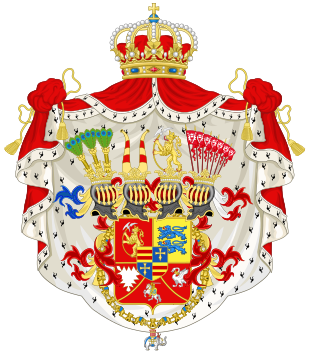House of Glücksburg
European royal house of German origin From Wikipedia, the free encyclopedia
The House of Schleswig-Holstein-Sonderburg-Glücksburg, also known by its short name as the House of Glücksburg, is the senior surviving branch of the German[1] House of Oldenburg, one of Europe's oldest royal houses. Oldenburg house members have reigned at various times in Denmark,[a] Norway, Sweden, Iceland, Greece, several northern German states, Russia[b] and the United Kingdom.[c] It takes its name from the family seat in Glücksburg, a small town in Schleswig-Holstein, Germany.
| House of Glücksburg | |
|---|---|
 | |
| Parent house | House of Oldenburg |
| Country | Duchy of Schleswig Duchy of Holstein Kingdom of Denmark Kingdom of Greece Kingdom of Iceland Kingdom of Norway United Kingdom of Great Britain and Northern Ireland |
| Founded | 6 July 1825 (17 December 1633 as Beck) |
| Founder | Friedrich Wilhelm (August Philipp as Beck) |
| Current head | Friedrich Ferdinand, Prince of Schleswig-Holstein (heir of the last extant ducal branch of the House of Schleswig-Holstein-Sonderburg) |
| Titles | |
| Connected families | Mountbatten-Windsor |
| Cadet branches | |
Current monarchs King Harald V of Norway and King Charles III of the United Kingdom, as well as the former Queen of Denmark Margrethe II and former queens consort Anne-Marie of Greece and Sofía of Spain, are patrilineal members of cadet branches of the House of Glücksburg.[3][4][5]
The present senior member of the House of Oldenburg and the House of Glücksburg and traditional heir to the family's ancestral lands, including Glücksburg itself, is Friedrich Ferdinand, Prince of Schleswig-Holstein (born 1985), who heads the foundation that owns the family's ancestral seat, Glücksburg Castle.
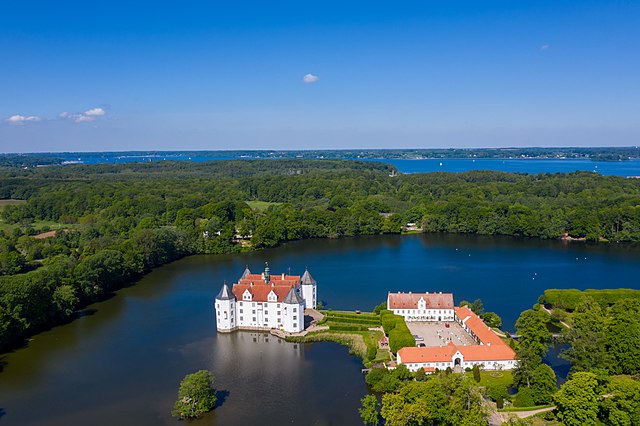
Etymology
Summarize
Perspective
"House of Glücksburg" is the shortened form of "House of Schleswig-Holstein-Sonderburg-Glücksburg"—a collateral branch of the House of Oldenburg. The house derives its name from two regions and two towns on the Jutland Peninsula.
The two regions of Schleswig and Holstein are divided by the Eider River. While Schleswig for centuries constituted the southernmost region of Denmark, Holstein historically has been the northernmost area within the Holy Roman Empire. The northern border of Holstein along the Eider had already formed the northern border of Francia and the Carolingian Empire, after Emperor Charlemagne upon the Saxon Wars reached an agreement with King Hemming of Denmark in 811. The lands of Schleswig beyond the river remained a fief of the Danish Crown, while Holstein became an integral part of East Francia, the Kingdom of Germany and the Holy Roman Empire. Even earlier, the Eider had already been the border river between Saxons and Polabian Slavs to the south, and Danes and North Frisians to the north. This is evidenced in the largely Slavic-derived toponomy in Eastern Holstein, as opposed to the many Danish-derived place names in Schleswig including Southern Schleswig. Since the 1920 Schleswig plebiscites, Schleswig has been divided between Denmark (Northern Schleswig), and Germany (Southern Schleswig).
The town of Sønderborg—the German name of which is "Sonderburg"—is located on the northern shores of the Flensburg Firth in Denmark (Northern Schleswig), while Glücksburg (Ostsee) lies on the southern shores of the firth in Germany (Southern Schleswig). The "Ostsee" suffix means "Baltic Sea" (East Sea).
Since Glücksburg Castle is the ancestral seat of the house, the house is mostly shortened to just "House of Glücksburg". It is also spelled "House of Glücksborg" (the name of Glücksburg in the local Low German dialect) or "House of Lyksborg" (the Danish name of Glücksburg).
The literal translation of "Glücksburg" is "Luck's Castle" (Glück = luck; Burg = castle). Glücksburg is officially bilingual and since 2016, there are German/Danish city limit signs in the town.
History
Summarize
Perspective

Glücksburg is a small coastal town on the German southern side of the fjord of Flensburg that divides Germany from Denmark.[4] In 1460, Glücksburg came, as part of the conjoined Dano-German duchies of Schleswig and Holstein, to Count Christian of Oldenburg whom, in 1448, the Danes had elected their king as Christian I, the Norwegians likewise taking him as their hereditary king in 1450.[4]
In 1564, Christian I's great-grandson, King Frederick II, in re-distributing Schleswig and Holstein's fiefs, retained some lands for his own senior royal line while allocating Glücksburg to his brother Duke John the Younger (1545–1622), along with Sønderborg, in appanage.[4] John's heirs further sub-divided their share and created, among other branches, a line of Schleswig-Holstein-Sonderburg dukes at Beck (an estate near Minden bought by the family in 1605), who remained vassals of Denmark's kings.[4]
By 1825, the castle of Glücksburg had returned to the Danish crown (from another ducal branch called Glücksburg, extinct in 1779) and was given that year by King Frederick VI, along with a new ducal title, to his kinsman Frederick of Schleswig-Holstein-Sonderburg-Beck.[7] Frederick suffixed the territorial designation to the ducal title he already held, in lieu of "Beck" (an estate the family had, in fact, sold in 1745).[4] Thus emerged the extant Dukes of Schleswig-Holstein-Sonderburg-Glücksburg.
The Danish line of Oldenburg kings died out in 1863, and the elder line of the Schleswig-Holstein family became extinct with the death of the last Augustenburg duke in 1931. Thereafter, the House of Glücksburg became the senior surviving line of the House of Oldenburg. Another cadet line of Oldenburgs, the Dukes of Holstein-Gottorp, consisted of two branches which held onto sovereignty into the 20th century. But members of the Romanov line were executed in or exiled from their Russian Empire in 1917, while the Grand Duchy of Oldenburg was abolished in 1918, although its dynastic line survives.[4]
Neither the Dukes of Beck nor of Glücksburg had been sovereign rulers; they held their lands in fief from the ruling Dukes of Schleswig and Holstein, i.e. the Kings of Denmark and (until 1773) the Dukes of Holstein-Gottorp.
Prince Christian of Schleswig-Holstein-Sonderburg-Glücksburg, the fourth son of Duke Friedrich of Glücksburg, was recognized in the London Protocol of 1852 as successor to the childless King Frederick VII of Denmark. He became King of Denmark as Christian IX on 15 November 1863.[4]
Prince Vilhelm, the second son of Crown Prince Christian and Crown Princess Luise, was elected King of the Hellenes on 30 March 1863, succeeding the ousted Wittelsbach Otto of Greece and reigning under the name George I.
Prince Carl, the second son of Frederick VIII of Denmark, Christian IX's eldest son, became King of Norway on 18 November 1905 as Haakon VII.
Christian IX's daughters, Alexandra and Dagmar (as Maria Feodorovna) became the consorts of, respectively, King Edward VII of the United Kingdom and Emperor Alexander III of Russia. As a result, by 1914 descendants of King Christian IX held the crowns of several European realms, and he became known as the "Father-in-law of Europe".
Christian IX's older brother inherited formal headship of the family as Karl, Duke of Schleswig-Holstein-Sonderburg-Glücksburg, followed by their brother Friedrich, Duke of Schleswig-Holstein-Sonderburg-Glücksburg. It is his descendants who now represent the senior line of the Schleswig-Holstein branch of the House of Oldenburg, with Friedrich Ferdinand, Prince of Schleswig-Holstein, as its current head.
Patrilineal ancestry of Duke Friedrich Wilhelm
- Elimar I, Count of Oldenburg
- Elimar II, Count of Oldenburg
- Christian I, Count of Oldenburg (Christian the Quarrelsome)
- Maurice, Count of Oldenburg
- Christian II, Count of Oldenburg
- John I, Count of Oldenburg
- Christian III, Count of Oldenburg
- John II, Count of Oldenburg
- Conrad I, Count of Oldenburg
- Christian V, Count of Oldenburg
- Dietrich, Count of Oldenburg
- Christian I of Denmark
- Frederick I of Denmark
- Christian III of Denmark
- John II, Duke of Schleswig-Holstein-Sonderburg
- Alexander, Duke of Schleswig-Holstein-Sonderburg
- August Philipp, Duke of Schleswig-Holstein-Sonderburg-Beck
- Frederick Louis, Duke of Schleswig-Holstein-Sonderburg-Beck
- Peter August, Duke of Schleswig-Holstein-Sonderburg-Beck
- Karl Anton August, Prince of Schleswig-Holstein-Sonderburg-Beck
- Friedrich Karl Ludwig, Duke of Schleswig-Holstein-Sonderburg-Beck
- Friedrich Wilhelm, Duke of Schleswig-Holstein-Sonderburg-Glücksburg
Schleswig-Holstein-Sonderburg-Glücksburg

The Dukes of Schleswig-Holstein-Sonderburg-Glücksburg constitute the senior male line of the branch. They hold the headship by primogeniture of the cadet house of Glücksburg. The headship by agnatic primogeniture of the entire House of Oldenburg is held by Friedrich Ferdinand, Prince of Schleswig-Holstein.
| Portrait | Name | Life | Reign |
|---|---|---|---|
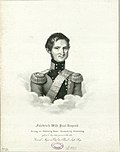 |
Friedrich Wilhelm, Duke of Schleswig-Holstein-Sonderburg-Glücksburg | 1785–1831 | 1825–1831 |
 |
Karl, Duke of Schleswig-Holstein-Sonderburg-Glücksburg | 1813–1878 | 1831–1878 |
 |
Friedrich, Duke of Schleswig-Holstein-Sonderburg-Glücksburg | 1814–1885 | 1878–1885 |
 |
Friedrich Ferdinand, Duke of Schleswig-Holstein | 1855–1934 | 1885–1934 |
 |
Wilhelm Friedrich, Duke of Schleswig-Holstein | 1891–1965 | 1934–1965 |
 |
Peter, Duke of Schleswig-Holstein | 1922–1980 | 1965–1980 |
 |
Christoph, Prince of Schleswig-Holstein | 1949–2023 | 1980–2023 |
 |
Friedrich Ferdinand, Prince of Schleswig-Holstein | born 1985 | 2023–present |
The heir apparent is Prince Alfred of Schleswig-Holstein (born 2019).
Denmark
Summarize
Perspective

In 1852, Prince Christian of Schleswig-Holstein-Sonderburg-Glücksburg became heir-presumptive to the Kingdom of Denmark, and in 1863, he ascended the throne. He was the fourth son of Friedrich Wilhelm, Duke of Schleswig-Holstein-Sonderburg-Glücksburg, whose elder brother (and male-line descendants) retained the Glücksburg dukedom. The Danish royal family still calls itself Glücksborg, using a slightly Danicized form of Glücksburg.[8]
| Portrait | Name | Life | Reign | Additional titles |
|---|---|---|---|---|
 |
Christian IX | 1818–1906 | 1863–1906 | King of the Wends King of the Goths Duke of Schleswig, Holstein, Stormarn, Dithmarschen, Lauenburg and Oldenburg Prior to ascending the throne: Prince of Schleswig-Holstein-Sonderburg-Glücksburg (Danish: Prins af Slesvig-Holsten-Sønderborg-Glückborg) |
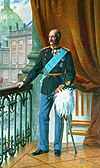 |
Frederik VIII | 1843–1912 | 1906–1912 | King of the Wends King of the Goths Duke of Schleswig, Holstein, Stormarn, Dithmarschen, Lauenburg and Oldenburg |
 |
Christian X | 1870–1947 | 1912–1947 | King of Iceland (used 1918–1944) King of the Wends King of the Goths Duke of Schleswig, Holstein, Stormarn, Dithmarschen, Lauenburg and Oldenburg |
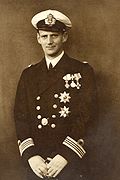 |
Frederik IX | 1899–1972 | 1947–1972 | King of the Wends King of the Goths Duke of Schleswig, Holstein, Stormarn, Dithmarschen, Lauenburg and Oldenburg |
 |
Margrethe II | born 1940 | 1972–2024 | |
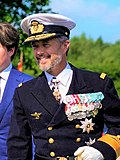 |
Frederik X[8][9][10][11] | born 1968 | 2024–present | Count of Monpezat |
Greece
Summarize
Perspective


In 1863 and with the name George I, Prince Wilhelm of Denmark was elected King of the Hellenes on the recommendation of Europe's Great Powers. He was the second son of King Christian IX of Denmark.
| Portrait | Name | Life | Reign | Additional titles |
|---|---|---|---|---|
 |
George I | 1845–1913 | 1863–1913 |
|
 |
Constantine I | 1868–1923 |
|
|
 |
Alexander | 1893–1920 | 1917–1920 |
|
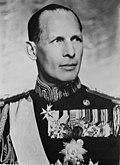 |
George II | 1890–1947 |
|
|
 |
Paul | 1901–1964 | 1947–1964 |
|
 |
Constantine II | 1940–2023 | 1964–1973 |
|
The Hellenic constitutional monarchy was usurped in a coup d'état by a military junta in 1967 and the royal family fled into exile. The monarchy was abolished in 1973. After the collapse of the military dictatorship in 1974, 69.18% of votes recorded in a republic referendum were against the restoration of the monarchy.
As of 2024, the family has assumed the last name "De Grèce" (Ντε Γκρες; "of Greece"), first used by Greek author and dynast Prince Michael of Greece and Denmark for his pen name as Michel de Grèce, as the only one familiar to them.[clarification needed][12]
Norway

In 1905, Prince Carl of Denmark became Norway's first independent monarch in 518 years, taking the regnal name Haakon VII. His father was King Frederick VIII of Denmark, and one of his uncles was King George I of Greece.
| Portrait | Name | Life | Reign | Additional titles |
|---|---|---|---|---|
 |
Haakon VII | 1872–1957 | 1905–1957 | Prince of Denmark, Prince of Schleswig-Holstein-Sonderburg-Glücksburg |
 |
Olav V | 1903–1991 | 1957–1991 | Prince of Denmark, Prince of Schleswig-Holstein-Sonderburg-Glücksburg, Olympic Sailing Champion [13] |
 |
Harald V | born 1937 | 1991–present | Prince of Denmark, Prince of Schleswig-Holstein-Sonderburg-Glücksburg, Sailing World Champion |
The heir apparent is Crown Prince Haakon of Norway (born 1973). See the present line of succession.
Iceland

In 1918, Iceland was elevated from an autonomous Danish province to a separate Kingdom of Iceland. Christian X of Denmark was henceforth King of Denmark and Iceland until 1944, when Iceland dissolved the personal union between the two countries and became a republic.
| Portrait | Name | Life | Reign | Additional titles |
|---|---|---|---|---|
 |
Kristján X | 1870–1947 | 1918–1944 |
|
The heir apparent was his son, Frederik IX of Denmark (1899–1972).
United Kingdom
Summarize
Perspective


In 1947, Philip Mountbatten married Princess Elizabeth (later Queen Elizabeth II). Born into the house of Glücksburg as a prince of Denmark and Greece, he later relinquished these titles and was created Duke of Edinburgh by his father-in-law, King George VI of the United Kingdom.
| Portrait | Name | Life | Tenure | Additional titles |
|---|---|---|---|---|
 |
Prince Philip, Duke of Edinburgh[4] | 1921–2021 | 1947–2021 |
Titles until 1947: Prince of Greece Prince of Denmark Titles from 1947: Earl of Merioneth Baron Greenwich |
 |
Charles III[a] | Born 1948 | 2021–present | Title from 1952–2022: Duke of Cornwall[b] Title from 1958–2022: Prince of Wales[c] Title from 2021–2022: Duke of Edinburgh[d] Title from 2022–present: King of the United Kingdom[e] |
The heir apparent is Charles's elder son William, Prince of Wales (born 1982). See the present line of succession.
- ^a Charles is agnatically descended from the House of Glücksburg via his father. However, he reigns as a member of the House of Windsor.[14]
- ^b Also Duke of Rothesay, Earl of Carrick, Baron of Renfrew, Lord of the Isles, and Prince and Great Steward of Scotland.
- ^c Also Earl of Chester.
- ^d Also Earl of Merioneth and Baron Greenwich.
- ^e Also King of Antigua and Barbuda, Australia, The Bahamas, Belize, Canada, Grenada, Jamaica, New Zealand, Papua New Guinea, Saint Kitts and Nevis, Saint Lucia, Saint Vincent and the Grenadines, Solomon Islands, Tuvalu, and Head of the Commonwealth.
Line of succession
Summarize
Perspective
By agnatic primogeniture:
- Frederick I of Denmark (1471–1533)
- Christian III of Denmark (1503–1559)
- John II, Duke of Schleswig-Holstein-Sonderburg (1545–1622)
- Alexander, Duke of Schleswig-Holstein-Sonderburg (1573–1627)
- August Philipp, Duke of Schleswig-Holstein-Sonderburg-Beck (1612–1675)
- Frederick Louis, Duke of Schleswig-Holstein-Sonderburg-Beck (1653–1728)
- Peter August, Duke of Schleswig-Holstein-Sonderburg-Beck (1697–1775)
- Prince Karl Anton August of Schleswig-Holstein-Sonderburg-Beck (1727–1759)
- Friedrich Karl Ludwig, Duke of Schleswig-Holstein-Sonderburg-Beck (1757–1816)
- Friedrich Wilhelm, Duke of Schleswig-Holstein-Sonderburg-Glücksburg (1785–1831)
- Friedrich, Duke of Schleswig-Holstein-Sonderburg-Glücksburg (1814–1885)
- Friedrich Ferdinand, Duke of Schleswig-Holstein (1855–1934)
- Wilhelm Friedrich, Duke of Schleswig-Holstein (1891–1965)
- Peter, Duke of Schleswig-Holstein (1922–1980)
- Christoph, Prince of Schleswig-Holstein (1949–2023)
 Friedrich Ferdinand, Prince of Schleswig-Holstein (b. 1985)
Friedrich Ferdinand, Prince of Schleswig-Holstein (b. 1985)
- (1) Prince Alfred of Schleswig-Holstein
- (2) Prince Albert of Schleswig-Holstein
- (3) Prince Constantin of Schleswig-Holstein (b. 1986)
- (4) Prince Tassilo of Schleswig-Holstein, Prince of Lyxborg
- (5) Prince Leopold of Schleswig-Holstein (b. 1991)
- (6) Prince Alexander of Schleswig-Holstein (b. 1953)
- (7) Prince Julian of Schleswig-Holstein (b. 1997)
- Christoph, Prince of Schleswig-Holstein (1949–2023)
- Peter, Duke of Schleswig-Holstein (1922–1980)
- Wilhelm Friedrich, Duke of Schleswig-Holstein (1891–1965)
- Friedrich Ferdinand, Duke of Schleswig-Holstein (1855–1934)
- Christian IX of Denmark (1818–1906)
- Frederick VIII of Denmark (1843–1912)
- Christian X of Denmark (1870–1947)
- Knud, Hereditary Prince of Denmark (1900–1976)
- (8) Count Ingolf of Rosenborg (b. 1940)
- Knud, Hereditary Prince of Denmark (1900–1976)
- Haakon VII of Norway (1872–1957)
- Olav V of Norway (1903–1991)
- (9) Harald V of Norway (b. 1937)
- (10) Haakon, Crown Prince of Norway (b. 1973)
- (11) Prince Sverre Magnus of Norway (b. 2005)
- (10) Haakon, Crown Prince of Norway (b. 1973)
- (9) Harald V of Norway (b. 1937)
- Olav V of Norway (1903–1991)
- Prince Harald of Denmark (1876–1949)
- Count Oluf of Rosenborg (1923–1990)
- (12) Count Ulrik of Rosenborg (b. 1950)
- (13) Count Philip of Rosenborg (b. 1986)
- (12) Count Ulrik of Rosenborg (b. 1950)
- Count Oluf of Rosenborg (1923–1990)
- Christian X of Denmark (1870–1947)
- George I of Greece (1845–1913)
- Constantine I of Greece (1868–1923)
- Paul of Greece (1901–1964)
- Constantine II of Greece (1940–2023)
- (14) Pavlos, Crown Prince of Greece (b. 1967)
- (15) Prince Constantine Alexios of Greece and Denmark (b. 1998)
- (16) Prince Achileas-Andreas of Greece and Denmark (b. 2000)
- (17) Prince Odysseas Kimon of Greece and Denmark (b. 2004)
- (18) Prince Aristide Stavros of Greece and Denmark (b. 2008)
- (19) Prince Nikolaos of Greece and Denmark (b. 1969)
- (20) Prince Philippos of Greece and Denmark (b. 1986)
- (14) Pavlos, Crown Prince of Greece (b. 1967)
- Constantine II of Greece (1940–2023)
- Paul of Greece (1901–1964)
- Prince Andrew of Greece and Denmark (1882–1944)
- Prince Philip, Duke of Edinburgh (1921–2021)
- (21) Charles III of the United Kingdom (b. 1948)
- (22) William, Prince of Wales (b. 1982)
- (23) Prince George of Wales (b. 2013)
- (24) Prince Louis of Wales (b. 2018)
- (25) Prince Harry, Duke of Sussex (b. 1984)
- (26) Prince Archie of Sussex (b. 2019)
- (22) William, Prince of Wales (b. 1982)
- (27) Prince Andrew, Duke of York (b. 1960)
- (28) Prince Edward, Duke of Edinburgh (b. 1964)
- (29) James Mountbatten-Windsor, Earl of Wessex (b. 2007)
- (21) Charles III of the United Kingdom (b. 1948)
- Prince Philip, Duke of Edinburgh (1921–2021)
- Constantine I of Greece (1868–1923)
- Prince Valdemar of Denmark (1858–1939)
- Prince Axel of Denmark (1888–1964)
- Count Flemming of Rosenborg (1922–2002)
- (30) Count Axel of Rosenborg (b. 1950)
- (31) Count Carl Johan of Rosenborg (b. 1979)
- (32) Count Alexander Flemming of Rosenborg (b. 1993)
- (33) Count Birger of Rosenborg (b. 1950)
- (34) Count Carl Johan of Rosenborg (b. 1952)
- (30) Count Axel of Rosenborg (b. 1950)
- Count Flemming of Rosenborg (1922–2002)
- Prince Erik, Count of Rosenborg (1890–1950)
- Count Christian of Rosenborg (1932–1997)
- (35) Count Valdemar of Rosenborg (b. 1965)
- (36) Count Nicolai of Rosenborg (b. 1997)
- (35) Count Valdemar of Rosenborg (b. 1965)
- Count Christian of Rosenborg (1932–1997)
- Prince Axel of Denmark (1888–1964)
- Frederick VIII of Denmark (1843–1912)
- Friedrich, Duke of Schleswig-Holstein-Sonderburg-Glücksburg (1814–1885)
- Friedrich Wilhelm, Duke of Schleswig-Holstein-Sonderburg-Glücksburg (1785–1831)
- Friedrich Karl Ludwig, Duke of Schleswig-Holstein-Sonderburg-Beck (1757–1816)
- Prince Karl Anton August of Schleswig-Holstein-Sonderburg-Beck (1727–1759)
- Peter August, Duke of Schleswig-Holstein-Sonderburg-Beck (1697–1775)
- Frederick Louis, Duke of Schleswig-Holstein-Sonderburg-Beck (1653–1728)
- August Philipp, Duke of Schleswig-Holstein-Sonderburg-Beck (1612–1675)
- Alexander, Duke of Schleswig-Holstein-Sonderburg (1573–1627)
- John II, Duke of Schleswig-Holstein-Sonderburg (1545–1622)
- Adolf, Duke of Holstein-Gottorp (1526–1586)
- John Adolf, Duke of Holstein-Gottorp (1575–1616)
- Frederick III, Duke of Holstein-Gottorp (1597–1659)
- Christian Albert, Duke of Holstein-Gottorp (1641–1695)
- Frederick IV, Duke of Holstein-Gottorp (1671–1702)
- Charles Frederick, Duke of Holstein-Gottorp (1700–1739)
- Peter III of Russia (1728–1762)
- Paul I of Russia (1754–1801)
- Nicholas I of Russia (1796–1855)
- Alexander II of Russia (1818–1881)
- Grand Duke Paul Alexandrovich of Russia (1860–1919)
- Grand Duke Dmitri Pavlovich of Russia (1891–1941)
- Prince Paul Dimitrievich Romanovsky-Ilyinsky (1928–2004)
- (37) Prince Dimitri Pavlovich Romanovsky-Ilyinsky (b. 1954)
- (38) Prince Michael Pavlovich Romanovsky-Ilyinsky (b. 1961)
- Prince Paul Dimitrievich Romanovsky-Ilyinsky (1928–2004)
- Grand Duke Dmitri Pavlovich of Russia (1891–1941)
- Prince George Alexandrovich Yurievsky (1872–1913)
- Prince Alexander Georgijevich Yurievsky (1900–1988)
- (39) Prince George Alexandrovich Yurievsky (b. 1961)
- Prince Alexander Georgijevich Yurievsky (1900–1988)
- Grand Duke Paul Alexandrovich of Russia (1860–1919)
- Grand Duke Michael Nicolaevich of Russia (1832–1909)
- Grand Duke Alexander Mikhailovich of Russia (1866–1933)
- Prince Andrei Alexandrovich of Russia (1897–1981)
- Andrew Andreevich, Prince of Russia (1923–2021)
- (40) Alexis Andreevich, Prince of Russia (b. 1953)
- (41) Prince Peter Andreevich of Russia (b. 1961)
- (42) Prince Andrew Andreevich of Russia (b. 1963)
- Andrew Andreevich, Prince of Russia (1923–2021)
- Prince Rostislav Alexandrovich of Russia (1902–1978)
- Prince Rostislav Rostislavovich of Russia (1938–1999)
- (43) Prince Rostislav Rostislavovich of Russia (b. 1985)
- (44) Prince Rostislav Rostislavovich of Russia (b. 2013)
- (45) Prince Mikhail Rostislavovich of Russia (b. 2015)
- (46) Prince Nikita Rostislavovich of Russia (b. 1987)
- (43) Prince Rostislav Rostislavovich of Russia (b. 1985)
- Prince Nicholas Rostislavovich of Russia (1945–2000)
- (47) Prince Nicholas Nicolaevich of Russia (b. 1968)
- (48) Prince Daniel Nicolaevich of Russia (b. 1972)
- (49) Prince Jackson Danielovich of Russia (b. 2009)
- Prince Rostislav Rostislavovich of Russia (1938–1999)
- Prince Andrei Alexandrovich of Russia (1897–1981)
- Grand Duke Alexander Mikhailovich of Russia (1866–1933)
- Alexander II of Russia (1818–1881)
- Nicholas I of Russia (1796–1855)
- Paul I of Russia (1754–1801)
- Peter III of Russia (1728–1762)
- Charles Frederick, Duke of Holstein-Gottorp (1700–1739)
- Prince Christian August of Holstein-Gottorp (1673–1726)
- Prince Georg Ludwig of Holstein-Gottorp (1719–1763)
- Peter I, Grand Duke of Oldenburg (1755–1829)
- Augustus, Grand Duke of Oldenburg (1783–1853)
- Peter II, Grand Duke of Oldenburg (1827–1900)
- Frederick Augustus II, Grand Duke of Oldenburg (1852–1931)
- Nikolaus, Hereditary Grand Duke of Oldenburg (1897–1970)
- Anton-Günther, Duke of Oldenburg (1923–2014)
- (50) Christian, Duke of Oldenburg (b. 1955)
- (51) Duke Alexander of Oldenburg (b. 1990)
- (52) Duke Philipp of Oldenburg (b. 1991)
- (53) Duke Anton Friedrich of Oldenburg (b. 1993)
- (50) Christian, Duke of Oldenburg (b. 1955)
- Duke Peter of Oldenburg (1926–2016)
- (54) Duke Nikolaus of Oldenburg (b. 1955)
- (55) Duke Christoph of Oldenburg (b. 1985)
- (56) Duke Georg of Oldenburg (b. 1990)
- (57) Duke Oscar of Oldenburg (b. 1991)
- (54) Duke Nikolaus of Oldenburg (b. 1955)
- Duke Friedrich August of Oldenburg (1936–2017)
- (58) Duke Paul-Wladimir of Oldenburg (b. 1969)
- (59) Duke Kirill of Oldenburg (b. 2002)
- (60) Duke Carlos of Oldenburg (b. 2004)
- (61) Duke Paul of Oldenburg (b. 2005)
- (58) Duke Paul-Wladimir of Oldenburg (b. 1969)
- (61) Duke Huno of Oldenburg (b. 1940)
- (62) Duke Johann of Oldenburg (b. 1940)
- (63) Duke Konstantin Nikolaus of Oldenburg (b. 1975)
- Anton-Günther, Duke of Oldenburg (1923–2014)
- Nikolaus, Hereditary Grand Duke of Oldenburg (1897–1970)
- Frederick Augustus II, Grand Duke of Oldenburg (1852–1931)
- Peter II, Grand Duke of Oldenburg (1827–1900)
- Augustus, Grand Duke of Oldenburg (1783–1853)
- Peter I, Grand Duke of Oldenburg (1755–1829)
- Prince Georg Ludwig of Holstein-Gottorp (1719–1763)
- Frederick IV, Duke of Holstein-Gottorp (1671–1702)
- Christian Albert, Duke of Holstein-Gottorp (1641–1695)
- Frederick III, Duke of Holstein-Gottorp (1597–1659)
- John Adolf, Duke of Holstein-Gottorp (1575–1616)
- Christian III of Denmark (1503–1559)
References
External links
Wikiwand - on
Seamless Wikipedia browsing. On steroids.
